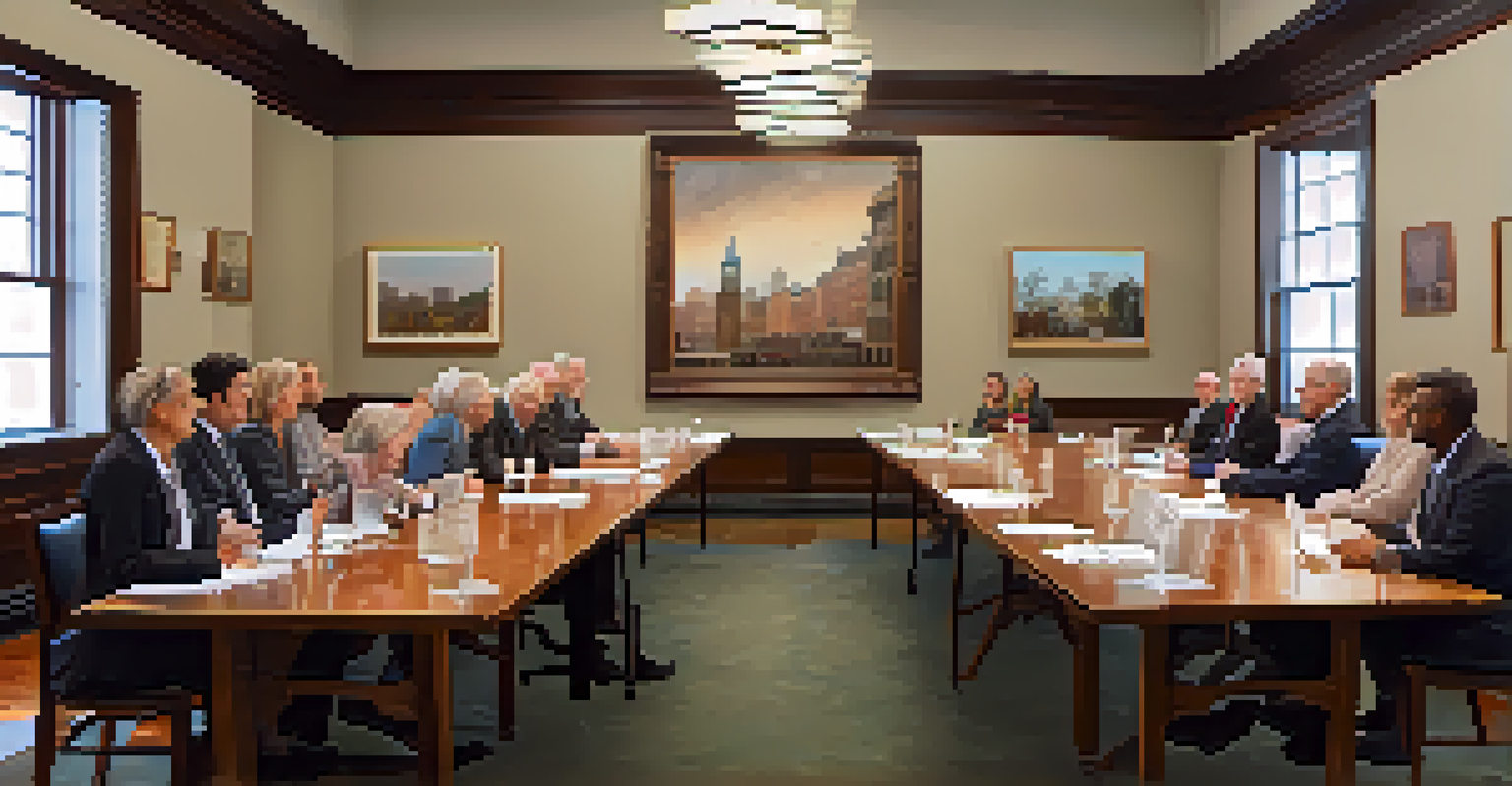Historic Preservation Regulations in NYC Real Estate

Overview of Historic Preservation in New York City
Historic preservation in New York City is a vital practice aimed at protecting the city's rich architectural heritage. It encompasses various laws and regulations that safeguard buildings of historical significance, ensuring that their stories are preserved for future generations. The city's unique blend of history and modernity makes these regulations essential in maintaining its character.
Preservation is a form of stewardship. It’s about taking care of what we have and passing it on to the next generation.
New York's preservation efforts are largely governed by the Landmarks Preservation Commission (LPC), which plays a crucial role in designating landmarks and historic districts. This commission evaluates buildings based on their historical, cultural, and architectural significance, making decisions that impact real estate development and renovations. Understanding how the LPC operates is key for anyone looking to navigate the NYC real estate landscape.
Preservation regulations not only protect the physical structures but also the cultural narratives attached to them. This means that when renovations or new developments are proposed, they must align with the established historic character of the area, promoting a cohesive urban environment that respects the past while accommodating the future.
The Role of the Landmarks Preservation Commission
The Landmarks Preservation Commission (LPC) is the heart of historic preservation in NYC, responsible for overseeing the city's landmarks and historic districts. Established in 1965, the LPC's mission is to preserve the architectural and cultural heritage of the city by designating and protecting significant sites. This designation process involves thorough research and public hearings, ensuring community involvement.

Once a building or district is designated, it is subject to specific regulations that dictate how it can be altered or maintained. These rules aim to retain the property's historic character, which can include restrictions on exterior changes, demolitions, and new constructions. For property owners, understanding these regulations is essential to avoid potential legal issues and fines.
Importance of LPC in Preservation
The Landmarks Preservation Commission (LPC) plays a crucial role in safeguarding NYC's historic sites by designating landmarks and enforcing preservation regulations.
Moreover, the LPC also provides guidelines and resources for property owners to help them navigate the preservation process. This support fosters a collaborative relationship between the commission and the community, encouraging responsible development that honors the city's historical narrative.
Designating a Landmark: The Process Explained
The process of designating a landmark in NYC is both thorough and comprehensive, reflecting the city's commitment to preservation. It begins with a nomination, which can be submitted by anyone, including community members or organizations. The LPC reviews these nominations and conducts extensive research to evaluate the significance of the proposed landmark.
Historic preservation is not about putting up a fence around history; it’s about creating a bridge to the future.
After the initial review, the LPC holds a public hearing to gather community feedback and discuss the nomination's merits. This is an opportunity for stakeholders and local residents to express their opinions, highlighting the importance of public involvement in the preservation process. Following the hearing, the LPC votes on whether to designate the site as a landmark.
If a site is designated, it becomes subject to preservation regulations, ensuring its historical integrity. This designation not only protects the physical structure but also enhances community pride and property values, demonstrating the positive impact of preservation on the local real estate market.
Impact of Preservation Regulations on Real Estate Development
Preservation regulations can significantly influence real estate development in New York City, often acting as a double-edged sword. On one hand, these regulations can create challenges for developers looking to modernize or expand, as they must navigate strict guidelines that dictate what changes can be made to historic properties. This can lead to increased costs and extended timelines.
On the other hand, properties in designated historic districts often see increased demand due to their unique charm and character. Buyers are frequently drawn to the allure of living in a historic neighborhood, which can drive up property values. As a result, developers may find opportunities in restoration projects, which can be both financially rewarding and culturally enriching.
Challenges in Balancing Modernization
Property owners face difficulties in updating historic buildings while adhering to strict preservation standards, requiring creativity and collaboration.
Moreover, the preservation of historic sites can enhance the overall appeal of a neighborhood, attracting tourism and supporting local businesses. This dynamic creates a balance between preserving the past and fostering economic growth, illustrating how preservation regulations shape the real estate landscape in NYC.
Common Challenges in Historic Preservation
While the objectives of historic preservation are noble, the process is not without its challenges. Property owners often face difficulties when attempting to navigate the complex regulations set forth by the LPC. These rules can be overwhelming, particularly for those unfamiliar with the preservation process, leading to frustration and confusion.
Additionally, balancing modernization with preservation can be a significant hurdle. Many property owners wish to update their buildings to meet contemporary needs, but these updates must comply with preservation standards. Finding this balance can require creativity and flexibility, as well as a willingness to collaborate with preservationists and the LPC.
Lastly, there can be resistance from some community members who either do not fully understand the benefits of preservation or who feel that regulations infringe on their property rights. Addressing these concerns through education and open dialogue is essential for fostering a supportive environment for preservation efforts.
Financial Incentives for Preservation Projects
Engaging in historic preservation can be costly, but there are financial incentives available to property owners that can help offset these expenses. The federal and state governments offer tax credits for rehabilitation projects that meet specific preservation criteria. These credits can significantly reduce renovation costs, making it more feasible to maintain the integrity of historic properties.
In addition to tax credits, NYC offers various grants and funding programs aimed at supporting preservation efforts. These resources are designed to encourage property owners to invest in their historic buildings, ensuring that they remain viable and well-maintained. Property owners can often find assistance through local preservation organizations that provide guidance on available funding options.
Financial Support for Preservation
Various financial incentives, including tax credits and grants, are available to help property owners offset the costs of maintaining historic properties.
By taking advantage of these financial incentives, property owners not only contribute to the preservation of the city's history but also enhance the value of their investments. This symbiotic relationship between financial support and preservation efforts underscores the importance of maintaining NYC’s unique architectural tapestry.
Future of Historic Preservation in NYC
As New York City continues to evolve, the future of historic preservation remains a topic of active discussion and development. The increasing demand for housing and commercial space often clashes with the need to preserve historic sites, making it crucial for policymakers and preservationists to find common ground. Innovative approaches and adaptive reuse strategies may provide paths forward that honor both preservation and development.
Technology also plays a significant role in shaping the future of historic preservation. Digital tools and resources can aid in documenting and analyzing historic properties, providing valuable data that can inform preservation efforts. Additionally, virtual reality and augmented reality technologies can help educate the public about the importance of preserving heritage.

Ultimately, the future of historic preservation in NYC will depend on collaboration between stakeholders, including the LPC, property owners, community members, and developers. By fostering open communication and innovative thinking, the city can continue to celebrate its rich history while accommodating the needs of a growing population.